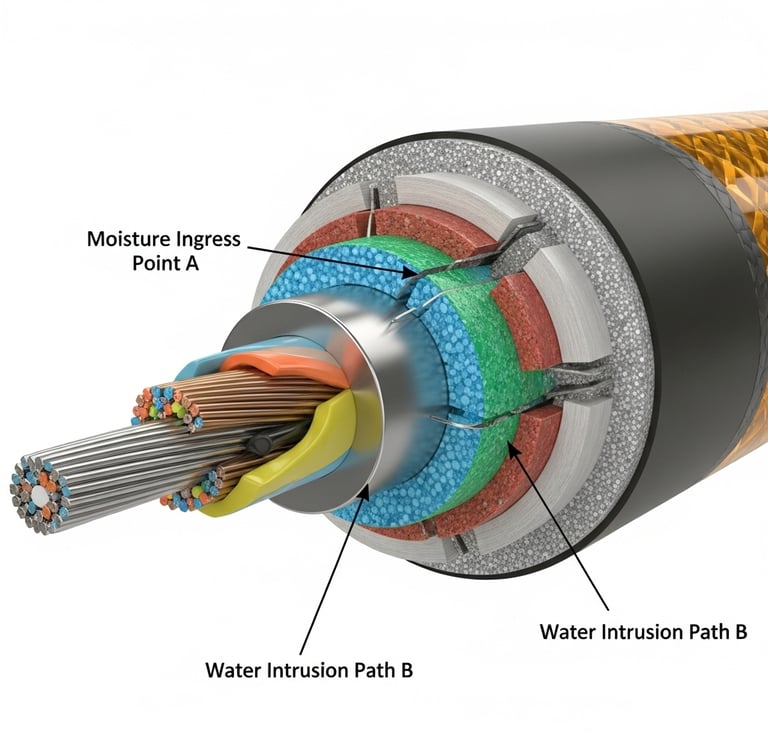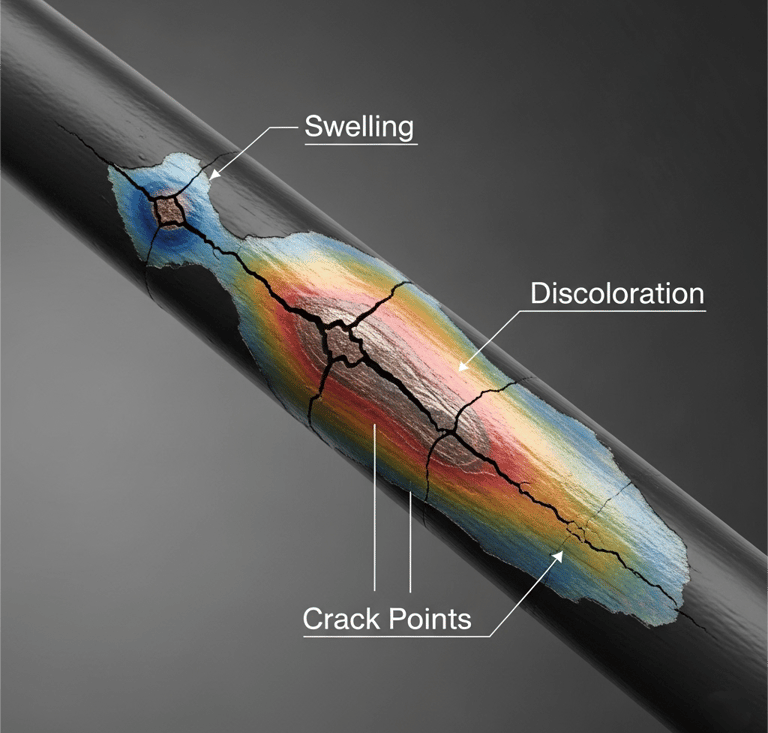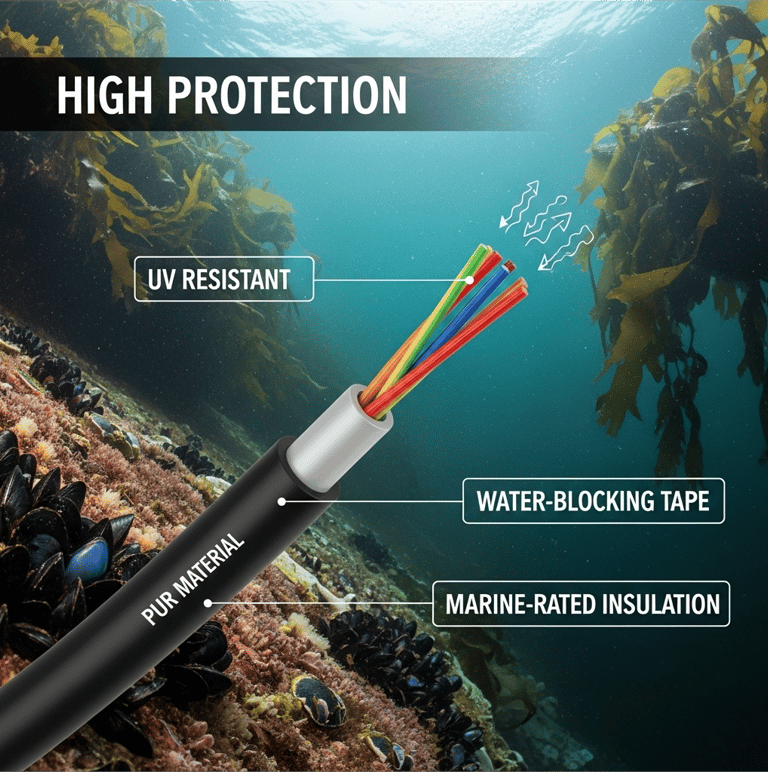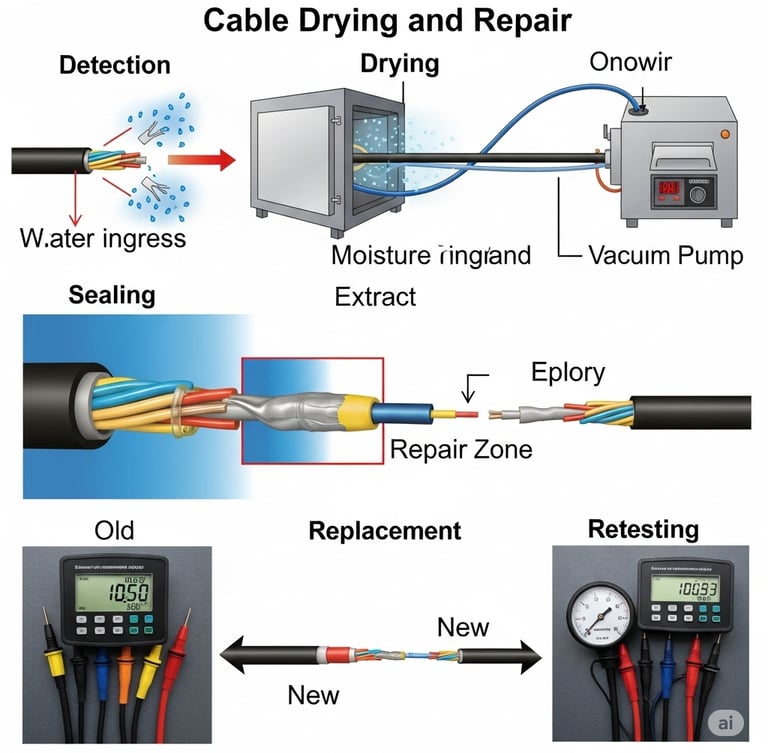📞+86 153 7530 2641 📧 hongjing.Wang@feichuncables.com
What Measures Should Be Taken When Water Ingress Occurs in Port Crane Cable Sheaths?
Discover effective measures to address water ingress in port crane cable sheaths, including inspection, drying, sealing, and long-term protection strategies to avoid costly failures.
hongjing.Wang@Feichun
7/18/20258 min read


Introduction
Water ingress in cable sheaths represents one of the most significant threats to port crane electrical systems. When moisture penetrates the protective outer layer of electrical cables, it creates a pathway for devastating equipment failures that can halt operations and compromise safety. Port crane cables face unique challenges in marine environments where saltwater spray, high humidity, and temperature fluctuations create the perfect storm for moisture infiltration.
The maritime setting makes port crane power cables particularly susceptible to water penetration compared to their inland counterparts. These cables must withstand constant exposure to corrosive saltwater, driving rain, and condensation cycles that can overwhelm even well-designed protective systems. Understanding how to respond quickly and effectively to water ingress in port crane cable sheaths is essential for maintaining operational continuity and preventing catastrophic system failures.
Immediate action upon detecting moisture in reeling cable sheaths can mean the difference between a simple repair and complete cable replacement. The consequences of delayed response extend beyond equipment costs, potentially causing extended downtime, safety hazards, and significant financial losses for port operations.
Common Causes of Water Ingress in Port Crane Cables
Environmental exposure stands as the primary culprit behind moisture damage in reeling cable sheath systems. The constant bombardment of saltwater spray creates microscopic pathways through cable materials, while repeated wetting and drying cycles cause expansion and contraction that eventually compromise sheath integrity. Heavy rainfall and fog contribute additional moisture loads that can overwhelm protective barriers.
Damaged outer sheaths often result from mechanical stress during cable installation or operation. Sharp edges on cable guides, excessive bending during reeling operations, and abrasion from debris can create entry points for water penetration. Even minor nicks or cuts in the sheath can allow moisture to migrate along the cable length through capillary action.
Improper sealing at termination points creates another common vulnerability. Poorly installed cable glands, inadequate environmental sealing, or degraded gaskets allow water to enter the cable system at its most vulnerable points. These termination failures often occur where cables enter equipment housings or junction boxes.
Cable design inadequacies become apparent in marine applications where standard industrial cables may lack sufficient protection against moisture ingress. Some cables lack proper water-blocking layers or use materials that degrade rapidly under marine conditions, making them unsuitable for port crane applications.
Immediate Warning Signs of Water Ingress
Visual indicators provide the first line of defense against water damage in harbor crane cables. Swelling of the cable sheath indicates moisture has penetrated the protective layer and is causing internal components to expand. Discoloration, particularly darkening or staining of the sheath material, suggests ongoing moisture exposure and potential chemical reactions with internal compounds.
Electrical performance degradation manifests as declining insulation resistance values during routine testing. Modern port operations rely on regular insulation resistance measurements using specialized testing equipment to detect early signs of moisture infiltration before complete failure occurs. Values below manufacturer specifications indicate compromised electrical integrity.
Intermittent faults during crane operation often signal advancing moisture damage. These temporary failures may initially appear as brief power interruptions or control system glitches but typically worsen over time as water continues to degrade electrical components. Operators should treat any unexplained electrical anomalies as potential indicators of water ingress.
Corrosion odors near cable terminations provide another warning sign of moisture-related damage. The distinctive smell of corroding metal components indicates that water has reached conductive elements within the cable system. Visual inspection of termination points may reveal white corrosion deposits or green oxidation on copper conductors.


Key Risks and Consequences of Water Ingress
Accelerated insulation degradation represents the most immediate threat from water penetration in port crane cables. Moisture creates conductive pathways that bypass normal insulation, leading to electrical leakage and eventual breakdown. This degradation process accelerates in marine environments where salt deposits increase conductivity and chemical reactions.
Short circuits pose severe operational risks, potentially causing immediate crane shutdown and creating safety hazards for personnel. When water bridges the gap between conductors or between conductors and ground, the resulting short circuit can damage control systems, motors, and other expensive electrical components throughout the crane system.
Irreversible damage to conductors and shielding occurs when moisture reaches the cable's core components. Copper conductors begin oxidizing upon water contact, creating resistance that generates heat and further accelerates degradation. Metallic shielding systems suffer similar corrosion damage that compromises their effectiveness in protecting against electromagnetic interference.
Safety hazards multiply when water-damaged cables remain in service. Electrical faults in port crane systems can endanger operators, maintenance personnel, and dock workers. The combination of high voltage systems and conductive saltwater creates particularly dangerous conditions that require immediate attention.


Immediate Response Measures
Visual inspection forms the foundation of immediate response to suspected water ingress. Trained personnel should examine the entire cable length for signs of sheath damage, paying particular attention to areas subject to mechanical stress such as cable guides, drums, and termination points. Thermal imaging cameras can reveal hot spots indicating internal moisture-related resistance.
Insulation resistance testing using calibrated megohmmeters provides quantitative assessment of cable condition. Testing should occur at multiple voltage levels to identify weak spots in the insulation system. Comparative measurements against baseline values help determine the extent of moisture penetration and guide repair decisions.
Breach point identification requires systematic testing to locate the exact entry point of water ingress. Specialized sheath integrity testing equipment can pinpoint cable faults by applying controlled electrical stress to the sheath while monitoring for breakdown. This precise location identification enables targeted repairs rather than wholesale cable replacement.
Documentation of all findings supports decision-making and provides valuable data for future preventive measures. Detailed records should include test results, photographic evidence of damage, and environmental conditions at the time of inspection.
Drying and Repair Methods
Hot air drying systems offer effective moisture removal for cables with limited water penetration. Specialized cable drying equipment circulates heated air through the cable while monitoring moisture levels to ensure complete drying. This method works best when water ingress is detected early and hasn't reached critical cable components.
Vacuum drying methods provide more aggressive moisture removal for severely compromised cables. By creating negative pressure within the cable system, vacuum drying can extract moisture from areas inaccessible to hot air systems. This technique requires specialized equipment and skilled technicians but can salvage cables with extensive water damage.
Self-amalgamating tapes and water-blocking gels provide temporary sealing solutions for damaged sheath sections. These materials create moisture barriers that prevent additional water ingress while permanent repairs are planned. Proper application requires clean, dry surfaces and careful attention to manufacturer specifications.
Section replacement becomes necessary when moisture penetration has caused irreversible damage to cable components. This involves removing the damaged portion and splicing in new cable using appropriate connectors and environmental sealing. Professional installation ensures proper electrical continuity and moisture protection.


Long-Term Solutions and Preventive Measures
Marine-grade cable selection represents the most effective long-term solution for preventing water ingress issues. Cables designed specifically for port applications feature enhanced sheath materials, integrated water-blocking layers, and superior resistance to saltwater corrosion. PUR-sheathed cables offer exceptional durability and chemical resistance suitable for marine environments.
Sealed termination systems provide critical protection at cable entry points. Heat-shrink sleeves with integrated sealants create watertight barriers at terminations, while gel-filled cable glands prevent moisture ingress through threaded connections. These systems require regular inspection and maintenance to ensure continued effectiveness.
Regular preventive maintenance programs enable early detection of potential problems before they develop into serious failures. Scheduled insulation resistance testing, visual inspections, and thermographic surveys help identify deteriorating conditions that require attention. Maintenance records provide valuable trend data for optimizing replacement schedules.
Water-blocking layers within cable design provide internal protection against moisture migration. Swellable tapes and water-blocking compounds create barriers that prevent water from traveling along the cable length even if the outer sheath is compromised. These features are particularly valuable in applications where external damage is likely.
Standards and Compliance Considerations
AS/NZS 2802 and IEC 60502 standards provide guidelines for low-voltage flexible cables used in mining and port applications. These standards specify minimum requirements for insulation thickness, sheath materials, and environmental resistance that ensure adequate protection against moisture ingress. Compliance with these standards helps ensure cable reliability and safety.
Installation guidelines for reeling cables in marine environments address specific challenges faced by port crane systems. These guidelines cover proper cable support, bend radius requirements, and environmental sealing techniques that minimize the risk of water ingress. Following established installation practices significantly reduces the likelihood of premature cable failure.
Regular compliance audits help maintain system reliability and identify areas requiring improvement. Professional assessments can evaluate existing cable systems against current standards and recommend upgrades where necessary. This proactive approach helps prevent costly failures and ensures continued operational safety.


Case Study: Successful Water Ingress Recovery
A major container port recently experienced water ingress in multiple crane cable systems following a severe storm. Initial symptoms included declining insulation resistance readings and intermittent electrical faults during crane operations. Immediate shutdown prevented further damage while technicians conducted comprehensive assessments.
The investigation revealed multiple breach points in cable sheaths caused by debris impact during the storm. Rather than replacing entire cable runs, the port implemented a systematic repair approach using vacuum drying techniques followed by targeted section replacement at the most severely damaged locations.
The repair process restored full functionality within 48 hours while providing valuable lessons for improving system resilience. Enhanced cable protection measures and modified maintenance procedures reduced similar incidents by 75% in subsequent years, demonstrating the value of comprehensive response strategies.
Q1: What are the main causes of water ingress in port crane cable sheaths?
A1: The main causes include physical damage to the sheath, poor sealing at terminations, high humidity, salt spray, and improper installation or storage near marine environments.
Q2: How can I detect moisture inside a port crane cable?
A2: You can detect it by performing insulation resistance tests, checking for cable swelling, corrosion at terminations, and monitoring for abnormal electrical behavior.
Q3: What should be done immediately if water ingress is suspected?
A3: Stop equipment operation, visually inspect the cable, perform insulation resistance testing, and identify the breach point for immediate sealing or section replacement.
Q4: Can a water-damaged port crane cable be repaired or must it be replaced?
A4: Minor damage can often be repaired by drying and resealing the cable, but severe water ingress may require partial or full cable replacement to ensure safety and performance.
Q5: How can future water ingress in crane cables be prevented?
A5: Use marine-grade cables with PUR sheathing, apply sealed terminations, perform regular maintenance and testing, and install cables with built-in water-blocking layers.
Q6: Which cable standards should be followed for port crane applications?
A6: Relevant standards include AS/NZS 2802, IEC 60502-1, and VDE 0250, all of which cover heavy-duty flexible cables suitable for harsh marine environments.
Conclusion
Effective response to water ingress in port crane cable sheaths requires immediate action, systematic assessment, and appropriate repair techniques. The marine environment presents unique challenges that demand specialized cable materials and enhanced protection systems. Success depends on combining rapid response capabilities with long-term preventive strategies.
Proactive detection through regular testing and inspection enables early intervention before minor problems become major failures. Investment in proper cable materials and installation techniques pays dividends through reduced maintenance costs and improved operational reliability. The key to success lies in treating cable protection as a critical system requiring ongoing attention and resources.
Port operators who prioritize cable system integrity through comprehensive maintenance programs and quality materials protect their investments while ensuring safe, reliable operations. The cost of prevention invariably proves less expensive than the consequences of failure, making proactive cable management an essential component of successful port operations.
How to Reach Us
Get in Touch
SiteMap
Product Catalogue
Reeling Cable
Festoon Cable
Shore Power Cable




Scan to add us on WeChat
